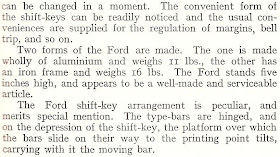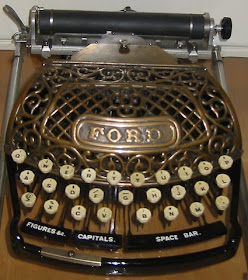JULY 28
THE FORD TYPEWRITER
A TRIUMPH OF PERSISTENCE
Howard collection
Wellington Parker Kidder’s Rochester pocket portable typewriter was being promoted in 1923 as the “Ford of the whole typewriter field”. Henry Ford’s Model T car, introduced in 1908, had set a benchmark for American machine manufacturing. But there was also a Ford typewriter, the work of Eugene Amzi Ford (below).“Tis a lesson you should heed, try, try again. If at first you don't succeed, try, try again.” This proverb has been traced back to the Teacher's Manual by American educator Thomas H. Palmer and was originally a maxim used to encourage schoolchildren to do their homework. The saying was popularised by Edward Hickson (1803-70) in his Moral Song.
Fortunately for typewriter collectors, it was a philosophy to which Eugene Amzi Ford also subscribed.
After being issued with a patent for his first typewriter design, on this day in 1891 (above), Ford persevered, and less than a year later patented the typewriter through which his name lives on. More of the 1891 design below:
Ford persisted with more or less the same style of angled three-bank keyboard, but abandoned what appears to be some sort of upstroke, if visible, typing action for one of the earliest examples of thrust-action typing. His second typewriter was also much smaller and lighter (below).
This typewriter did go into production, in 1895. To enhance its compactness, Ford also developed an aluminium body for it. Cast iron base Fords were sold in Germany as the Knoch (through Adolf Knoch, see the example from Uwe Breker's collection below) and in France through the Hurtu chain, which also sold bicycles. Parts for these were assembled Saalfeld and Paris.
The Ford typewriter’s outstanding feature is its front shield, covering the type mechanism. The ornate, copper striped latticework design has won the heart of many of happy collector.
One such is Martin Howard, many of whose images are seen here. Martin describes the Ford typewriter as “a striking machine with its beautiful ornate grill and gracefully integrated keyboard. It was a machine to grace the eyes but would not have endeared itself to the typist, as the keys are rather springy and wobbly when typing and the platen surprisingly does not have a line-by-line clicking action …
"However, what the Ford did have was visible writing, allowing one to see the typed words on the platen as soon as they were typed. It was not the first to do this, but most contemporary typewriters were still blind writers, requiring one to lift the carriage to see the last few typed lines.
“The Ford typewriter broke new ground in being the first typewriter to use the new metal aluminum in its construction.
"The Ford was sold in two versions, one with an all aluminum frame and carriage and the other with a cast iron, black enameled, frame and aluminum carriage. Both had a beautiful Japanned grill.”
With the establishment of IBM in 1911, Eugene Amzi Ford (right in the IBM group photograph above) became its senior development engineer.
Seven years earlier, in 1904, Ford had joined the Tabulating Machine Company. IBM began as the Computing Tabulating Recording Corporation through a merger of four companies: the Tabulating Machine Company, the International Time Recording Company, the Computing Scale Corporation and the Bundy Manufacturing Company. Three years later, when this conglomerate came under single management for the first time, Thomas John Watson Snr joined the organisation as general manager, and soon became its president. In 1924, the name International Business Machines Corporation was adopted.
Under Watson’s leadership, Ford came to be recognised by IBM as a pioneer in the development of many of its machines.
Eugene Amzi Ford (seen above, on his 80th birthday in 1946) was born on May 26, 1866, in Kosciusko, Attala, Mississippi. He entered the University of Mississippi at Oxford at 16. Ford later went to Texas and worked in a surveying party as chain man, surveying the county lines. He attended business college in Louisville, Kentucky, and subsequently became associated with a law firm.
Ford moved to New York in 1897 in an effort to get backing for his Ford Typewriter Company.
One of the companies he approached was Taft-Pierce in Woonsocket, Rhode Island, and he became associated with that organisation in aiding the development of a key punch. He later worked on a vertical sorter and counter device, developing the horizontal sorter in 1903.
Ford did not join Herman Hollerith’s Tabulating Machine Company until the following year, eight years after Hollerith (above) had formed it, and 14 years after Hollerith’s mechanical punched card data processing equipment had revolutionised the collecting and disseminating of information for the US Census. Ford had nothing to do with the original concept of Hollerith’s device.
But Ford did continue work on the development of punched card accounting machines.
After Hollerith had had a falling out with the US Government over money and other issues (he also later fell out with Watson, below), Hollerith sold his company and it was merged into what became IBM under Watson's management. Ford was one of his former colleagues who jumped ship.
Ford opened a small laboratory for IBM in Oxbridge, Massachusetts, in 1911, and three years later went to New York City as chief development engineer when the laboratory moved to East 30th Street in Manhattan.
Ford patented many improvements to punched card accounting machines, sorters and counter devices and developed the highly successful IBM 080 horizontal sorter, which was introduced commercially in 1925.
In 1933, Ford went to Endicott, where IBM had completed a new laboratory, and he made it IBM’s centre of operations. His contributions to the development and growth of the IBM line of products continued into the 1940s, when during World War II IBM carried on important research work for the US Government (see earlier post).
At an 80th birthday bash for Ford at the IBM Homestead in Endicott in 1946 (above), Watson said Ford “had always looked ahead to see better things for the future”. “Mr Ford has continued in that spirit through his many years with the company.
"Mr Ford was the first man I met in the development end of our business and he gave me great encouragement and assistance … I have never worked with anyone with more satisfaction and pleasure than I have worked with Mr Ford …”
Eugene Amzi Ford died on September 4, 1948.
On this day in 1929, former First Lady Jacqueline Lee Bouvier "Jackie" Kennedy Onassis was born in Southampton, New York. She died in New York City on May 19, 1994, aged 64.
































Thanks for this interesting - as always! - post.
ReplyDelete